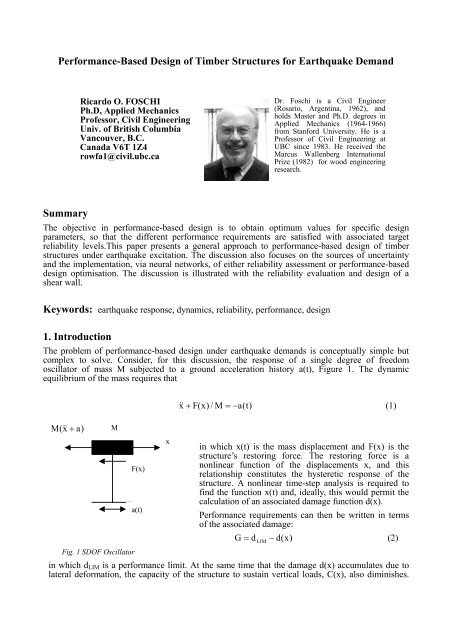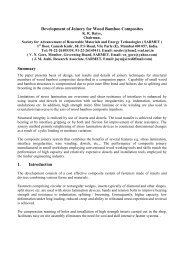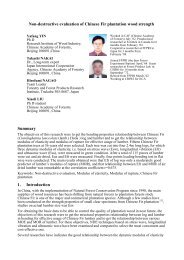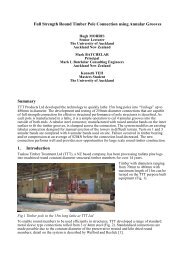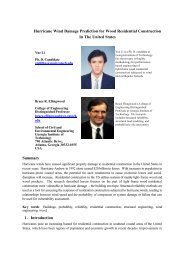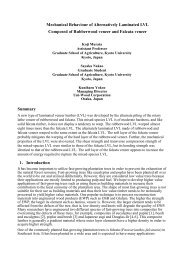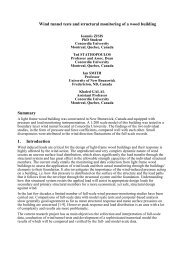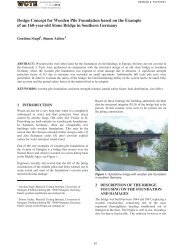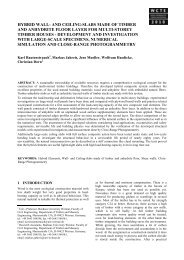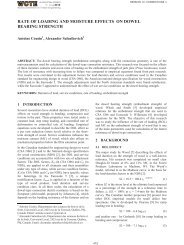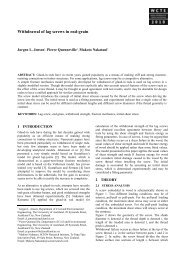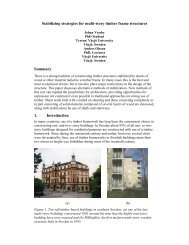Performance-Based Design of Timber Structures for Earthquake ...
Performance-Based Design of Timber Structures for Earthquake ...
Performance-Based Design of Timber Structures for Earthquake ...
You also want an ePaper? Increase the reach of your titles
YUMPU automatically turns print PDFs into web optimized ePapers that Google loves.
<strong>Per<strong>for</strong>mance</strong>-<strong>Based</strong> <strong>Design</strong> <strong>of</strong> <strong>Timber</strong> <strong>Structures</strong> <strong>for</strong> <strong>Earthquake</strong> Demand<br />
Ricardo O. FOSCHI<br />
Ph.D, Applied Mechanics<br />
Pr<strong>of</strong>essor, Civil Engineering<br />
Univ. <strong>of</strong> British Columbia<br />
Vancouver, B.C.<br />
Canada V6T 1Z4<br />
rowfa1@civil.ubc.ca<br />
Dr. Foschi is a Civil Engineer<br />
(Rosario, Argentina, 1962), and<br />
holds Master and Ph.D. degrees in<br />
Applied Mechanics (1964-1966)<br />
from Stan<strong>for</strong>d University. He is a<br />
Pr<strong>of</strong>essor <strong>of</strong> Civil Engineering at<br />
UBC since 1983. He received the<br />
Marcus Wallenberg International<br />
Prize (1982) <strong>for</strong> wood engineering<br />
research.<br />
Summary<br />
The objective in per<strong>for</strong>mance-based design is to obtain optimum values <strong>for</strong> specific design<br />
parameters, so that the different per<strong>for</strong>mance requirements are satisfied with associated target<br />
reliability levels.This paper presents a general approach to per<strong>for</strong>mance-based design <strong>of</strong> timber<br />
structures under earthquake excitation. The discussion also focuses on the sources <strong>of</strong> uncertainty<br />
and the implementation, via neural networks, <strong>of</strong> either reliability assessment or per<strong>for</strong>mance-based<br />
design optimisation. The discussion is illustrated with the reliability evaluation and design <strong>of</strong> a<br />
shear wall.<br />
Keywords: earthquake response, dynamics, reliability, per<strong>for</strong>mance, design<br />
1. Introduction<br />
The problem <strong>of</strong> per<strong>for</strong>mance-based design under earthquake demands is conceptually simple but<br />
complex to solve. Consider, <strong>for</strong> this discussion, the response <strong>of</strong> a single degree <strong>of</strong> freedom<br />
oscillator <strong>of</strong> mass M subjected to a ground acceleration history a(t), Figure 1. The dynamic<br />
equilibrium <strong>of</strong> the mass requires that<br />
M( x<br />
a)<br />
M<br />
Fig. 1 SDOF Oscillator<br />
F(x)<br />
a(t)<br />
x<br />
x F(<br />
x)<br />
/ M a(<br />
t)<br />
(1)<br />
in which x(t) is the mass displacement and F(x) is the<br />
structure’s restoring <strong>for</strong>ce. The restoring <strong>for</strong>ce is a<br />
nonlinear function <strong>of</strong> the displacements x, and this<br />
relationship constitutes the hysteretic response <strong>of</strong> the<br />
structure. A nonlinear time-step analysis is required to<br />
find the function x(t) and, ideally, this would permit the<br />
calculation <strong>of</strong> an associated damage function d(x).<br />
<strong>Per<strong>for</strong>mance</strong> requirements can then be written in terms<br />
<strong>of</strong> the associated damage:<br />
G d LIM d(<br />
x)<br />
(2)<br />
in which dLIM is a per<strong>for</strong>mance limit. At the same time that the damage d(x) accumulates due to<br />
lateral de<strong>for</strong>mation, the capacity <strong>of</strong> the structure to sustain vertical loads, C(x), also diminishes.
Thus, the probability <strong>of</strong> collapse must be studied with another per<strong>for</strong>mance function<br />
G C(<br />
x)<br />
W<br />
(3)<br />
in which W is the weight supported by the structure. The objective is to determine structural<br />
parameters (sizes, mechanical properties) so that the per<strong>for</strong>mance requirements are met with target<br />
reliability levels.<br />
Equation (1) shows clearly the major sources <strong>of</strong> uncertainty in the problem: 1) the ground motion<br />
a(t) and 2) the characteristics <strong>of</strong> the restoring <strong>for</strong>ce F(x). There are also additional uncertainties<br />
related to the relationship between the displacements x and the damage function d(x) or the axial<br />
capacity C(x). Let us consider these uncertainty sources one at a time.<br />
1.1 The Ground Motion<br />
The dynamic equation requires the ground acceleration function in its right-hand side. This<br />
function will have a peak value, a corresponding frequency content, and a duration <strong>for</strong> the<br />
segment <strong>of</strong> strong motion. Essentially, these are all basic random variables in the ground motion<br />
characterization. A sample <strong>of</strong> earthquake records, likely to affect the site, need to be used to<br />
characterize the randomness in the input motion. These records could be artificially generated or<br />
could be historical. It does not make too much sense to study the problem mixing in records from<br />
far away places (e.g., <strong>for</strong> a structure in Canada to use records from Japan or Chile). It is a major<br />
problem in seismology to pinpoint site-specific ground motion statistics, and this shortcoming<br />
must be recognized and be the subject <strong>of</strong> continuing studies.<br />
1.2 The Restoring Force<br />
The characterization <strong>of</strong> the restoring <strong>for</strong>ce, or hysteretic behaviour, as a function <strong>of</strong> displacements<br />
is also quite difficult. It must be recognized that F(x) is a function <strong>of</strong> x(t) or <strong>of</strong> the input history.<br />
There<strong>for</strong>e, it is not a material property and it cannot be measured ahead <strong>of</strong> time using any other<br />
history. Frequently, however, F(x) is characterized by a standard cyclic test following an agreedupon<br />
protocol. The results are then fitted with a specific <strong>for</strong>m <strong>for</strong> F(x), usually one appearing in<br />
standard structural analysis programs, and this <strong>for</strong>m <strong>for</strong> F(x) is then used to analyze the response<br />
<strong>for</strong> any other history or earthquake. This, basically, is not right. Protocols, in this sense, are <strong>of</strong> no<br />
use unless just utilized to compare one structural shape against another, both under the same<br />
demand. Although this approach is not right, the question remains as to whether it is sufficiently<br />
accurate. Of course, this question cannot be answered without a trusted benchmark but, again,<br />
Equation 1 gives us a hint <strong>of</strong> when the errors in F(x) might be <strong>of</strong> minor importance. Obviously, <strong>for</strong><br />
structures with a heavy mass M, (long period), the importance <strong>of</strong> errors in F(x) will be small.<br />
Lighter structures might not be so <strong>for</strong>tunate, and wood structures might fall into this category.<br />
In general, F(x) shows characteristics which will influence the structural response: 1) pinching <strong>of</strong><br />
the hysteretic loop; and 2) degradation in stiffness and strength. These, in turn, will be influenced<br />
by basic properties like yielding strengths, initial moduli <strong>of</strong> elasticity, different behaviours in<br />
tension and compression; appearance <strong>of</strong> cracks, etc. What is needed is a mechanical model <strong>for</strong><br />
F(x), with proper constitutive equations <strong>for</strong> the intervening elements. Such a model would permit<br />
the estimation <strong>of</strong> F(x) no matter what the demand history, and only then the response x(t) can be<br />
estimated with some confidence. A mechanical model <strong>for</strong> hysteretic response <strong>of</strong> timber fasteners<br />
has been developed [1] and implemented in the dynamic analysis <strong>of</strong> timber frames and shear<br />
walls [2].<br />
For reliability analysis, the use <strong>of</strong> ad-hoc hysteresis models would require the introduction <strong>of</strong> a<br />
model error with a larger uncertainty than what would be needed in the case <strong>of</strong> a more detailed<br />
and robust approach to calculating F(x).<br />
A reliability-based comparison between using a calculated hysteretic loop and a fitted model<br />
(Bouc-Wen-Baber-Noori) [3,4] <strong>for</strong> a pile foundation is shown by Foschi in [5]. Although the<br />
BWBN model can fit the test hysteresis quite well <strong>for</strong> the chosen cyclic protocol, reliability under<br />
earthquake demands can show substantial differences. Similarly, [5] shows substantial differences<br />
in per<strong>for</strong>mance-based design, when the design parameter is the mass carried by the pile. The
ehaviour <strong>of</strong> a pile is conceptually identical to that <strong>of</strong> a pin fastener joining wood layers, and the<br />
conclusions in [5] can be equally applied to timber fastening systems.<br />
1.3 Damage and Axial Capacity<br />
<strong>Per<strong>for</strong>mance</strong> requirements must be ultimately written in terms <strong>of</strong> damage, because only then can<br />
one assess the probabilities <strong>of</strong> different consequences and make decisions about cost <strong>of</strong> repairs,<br />
replacements or retr<strong>of</strong>its. Of course, collapse is an extreme <strong>for</strong>m <strong>of</strong> damage due to axial or vertical<br />
capacity degrading below the weight <strong>of</strong> the structure. The relationship between damage states and<br />
displacements, d(x), and the axial capacity function C(x), are quite difficult to obtain and <strong>for</strong>m<br />
part <strong>of</strong> the general current research in earthquake engineering. As an intermediate step, however,<br />
damage itself could be assimilated with displacements, requiring, <strong>for</strong> example, that the largest<br />
sway <strong>of</strong> a shear wall during an earthquake should be allowed to exceed a tolerable displacement<br />
only with a small target probability. Similarly, “collapse” could be assimilated with a rather large<br />
sway, on the assumption that such a situation would lead to vertical collapse. However, <strong>for</strong> the<br />
moment, these would be assumptions to be improved by extensive testing, and this should be a<br />
priority in earthquake research.<br />
2. Dynamic Analysis<br />
Equation (1) needs to be solved to obtain the output time history x(t). Time-stepping integration <strong>of</strong><br />
this equation should be the default approach. Several other strategies have been proposed, based<br />
on an elastic structure, mainly to save time or to make use <strong>of</strong> much simpler analyses like modal<br />
superposition. This approach, while holding the promise <strong>of</strong> a fast integration, leaves open the<br />
question <strong>of</strong> what to do about a correction to the elastic analysis in order to obtain the desired<br />
nonlinear response. These corrections rely on assumptions about the equality <strong>of</strong> the displacements<br />
in the two cases, an assumption which may be sufficiently approximate in some cases, completely<br />
false in others. In any case, there is no need to resort to such assumptions when direct integration<br />
<strong>of</strong> the equations <strong>of</strong> motion is facilitated by good algorithms and fast computers.<br />
3. Reliability and <strong>Per<strong>for</strong>mance</strong>-<strong>Based</strong> <strong>Design</strong><br />
The study <strong>of</strong> structural reliability requires the definition <strong>of</strong> a per<strong>for</strong>mance function G, in terms <strong>of</strong><br />
the variables entering into the models <strong>for</strong> capacity and demand. Assuming that damage d(x) can<br />
be represented by the maximum displacement Xmax produced by the earthquake, Equation (2) can<br />
be rewritten<br />
G = X Lim - Xmax ( x1 , x2 , … , xN ) (4)<br />
in which XLim is the limiting displacement and the set <strong>of</strong> ( x1 , x2 , … , xN ) includes all the<br />
intervening variables in the problem. Note that some <strong>of</strong> these may not be random but actually a<br />
design parameter like nail spacing in a shear wall. The probability <strong>of</strong> failure associated with<br />
Equation (4) corresponds to the probability <strong>of</strong> the event G
FORM and an approximating quadratic response surface. The simulations around that point are<br />
then implemented using a neural network representation <strong>of</strong> Xmax. This approach has proven to be<br />
very effective and the corresponding algorithms have been implemented in the s<strong>of</strong>tware RELAN<br />
developed at the University <strong>of</strong> British Columbia [8].<br />
In earthquake engineering, one <strong>of</strong> the random variables is the earthquake itself. If the peak ground<br />
acceleration is taken on its own, the remaining randomness <strong>of</strong> the earthquakes can be represented<br />
by a set <strong>of</strong> records normalized to a unit peak acceleration. Thus, it is convenient to develop two<br />
neural networks <strong>for</strong> a desired response R ( Xmax in this case): one <strong>for</strong> the average value <strong>of</strong> R over<br />
the set <strong>of</strong> normalized records, and the other <strong>for</strong> the standard deviation or the coefficient <strong>of</strong><br />
variation <strong>of</strong> the response R over the same set <strong>of</strong> records. Both <strong>of</strong> these networks use as input the<br />
set <strong>of</strong> remaining variables. Thus, the response R can then be written, <strong>for</strong> example, as having a<br />
lognormal distribution :<br />
R<br />
2<br />
R exp[ RN ln( 1<br />
VR<br />
)<br />
(5)<br />
2<br />
( 1<br />
V )<br />
R<br />
in which R is the average obtained from its neural network, and VR is the coefficient <strong>of</strong> variation<br />
calculated from its corresponding network.<br />
RN is a Standard Normal variable which thus represents the uncertainty due to different<br />
earthquake records.<br />
For per<strong>for</strong>mance-based design, the problem must be <strong>for</strong>mulated as follows: obtain a set <strong>of</strong> design<br />
parameters D so that the cost <strong>of</strong> the structure C(D) (including the cost <strong>of</strong> failure) is minimized,<br />
subject to target reliability levels being met or exceeded <strong>for</strong> a set <strong>of</strong> per<strong>for</strong>mance requirements.<br />
Thus,<br />
(D) = C(D) Minimum (6)<br />
Subject to i (D) Ti ( i = 1, M)<br />
and Lj < Dj < Uj (j = 1, ND)<br />
in which i(D) are the reliability levels achieved with the set D, <strong>for</strong> each <strong>of</strong> M per<strong>for</strong>mance<br />
requirements, and Ti are the corresponding target levels. In addition, <strong>for</strong> practical reasons, each <strong>of</strong><br />
the ND components <strong>of</strong> the design parameters D have to be between a corresponding lower bound L<br />
and an upper bound U. If cost is not addressed, and the objective is to calculate D so that the target<br />
reliabilities are achieved as closely as possible, Equation (6) can be modified as follows,<br />
(D) = 2<br />
M<br />
T i i ( D)<br />
i1<br />
Minimum (7)<br />
The algorithms <strong>for</strong> per<strong>for</strong>mance-based design, according to either Equations (6) or (7), have been<br />
implemented in the s<strong>of</strong>tware IRELAN developed at the University <strong>of</strong> British Columbia [8].<br />
4. Example: A Shear Wall<br />
A shear wall, shown in Figure 2, supports a mass M and is exposed to earthquakes with<br />
accelerations a(t). The shear wall is <strong>of</strong> standard construction, using Oriented Strand Board<br />
sheathing (one side only) and vertical framing at 400mm spacing, with 63.5mm Bright Common<br />
nails. The wall height and length are both 2.44m. The earthquake accelerograms, normalized to a<br />
peak <strong>of</strong> 1 m/sec 2 , were obtained from the spectral properties and duration <strong>of</strong> the 1992 event at<br />
Landers, CA, Joshua Tree Station.
The random variables in this problem are the mass M, the peak ground acceleration aG , and the two<br />
nail spacings e1 and e2 . Other wood properties <strong>for</strong> the frame and the sheathing were considered<br />
deterministic, as the behaviour <strong>of</strong> the fastenings is the most important factor <strong>for</strong> the wall response.<br />
The response <strong>of</strong> interest is the maximum wall lateral displacement . Table 1 shows the ranges <strong>for</strong><br />
the variable combinations adopted <strong>for</strong> creation <strong>of</strong> the response database, used <strong>for</strong> training <strong>of</strong> neural<br />
networks <strong>for</strong> the mean response ( e1,<br />
e 2 , M,<br />
a G ) and coefficient <strong>of</strong> variation V( e1<br />
, e 2 , M,<br />
a G ) . The<br />
structural dynamic analysis implemented hysteresis loops <strong>for</strong> each fastener, calculated using the<br />
mechanics-based model HYST [1].<br />
The combinations were selected with an optimal grid-based experimental design, achieving<br />
coverage <strong>of</strong> the variable space that maximized the minimum distance between combinations.<br />
Framing<br />
Member<br />
e2<br />
Fastener<br />
Mass<br />
a(t)<br />
Sheathing<br />
Panel<br />
e1<br />
Table 1. Variable range <strong>for</strong> the response databases.<br />
Table 2. Variable statistics<br />
Fig. 2 Shear Wall and <strong>Earthquake</strong> Demand<br />
With the statistics <strong>of</strong> Table 2, the reliability <strong>of</strong> the<br />
wall was evaluated <strong>for</strong> two per<strong>for</strong>mance criteria, as shown in Table 3, with achieved reliability<br />
indeces also shown in the same table.<br />
Table 3. Reliability indices , variable statistics from Table 2.<br />
<strong>Per<strong>for</strong>mance</strong> Requirement <br />
< H/300 (Serviceability, “no damage”) 1.870<br />
< H/200 (Minor damage) 2.693<br />
Finally, assume that the target reliability levels required <strong>for</strong> the two per<strong>for</strong>mance criteria are as<br />
follows:<br />
= 1.65 (or 5% exceedence probability) <strong>for</strong> < H/300<br />
= 2.56 (or 0.5% exceedence probability) <strong>for</strong> < H/200<br />
Variable Lower Limit Upper Limit<br />
e1 (m) 0.010 0.075<br />
e2 (m)<br />
aG (m/sec<br />
0.025 0.150<br />
2 )<br />
M<br />
(kN.sec<br />
0.500 3.500<br />
2 Variable Mean COV Distributio<br />
n<br />
e1 (m)<br />
e2 (m)<br />
aG (m/sec<br />
/m)<br />
0.050<br />
0.125<br />
2.000<br />
0.10<br />
0.10<br />
Normal<br />
Normal<br />
8.000<br />
2 )<br />
M<br />
(kN.sec<br />
0.981(0.1g) 0.55 Lognormal<br />
2 /m)<br />
6.0 0.10 Normal<br />
and that the design parameters are the mean values <strong>for</strong> the nail spacing e1 and e2 , allowing in each<br />
case a coefficient <strong>of</strong> variation <strong>of</strong> 0.10 <strong>for</strong> nailing innacuracies. Table 4 shows the result <strong>of</strong> the<br />
per<strong>for</strong>mance-based design optimization. Alternatively, given the nail spacing, the design parameter<br />
could have been the mean mass M, or the mean peak ground acceleration aG which would be<br />
tolerated by the wall with the required target reliabilities.
Table 4. <strong>Per<strong>for</strong>mance</strong>-based design, target reliabilities and<br />
optimum mean nail spacings<br />
<strong>Per<strong>for</strong>mance</strong><br />
Requirement<br />
< H/300<br />
(Serviceability,<br />
“no damage”)<br />
< H/200<br />
(Minor damage)<br />
5. Conclusions<br />
This paper has discussed the problem <strong>of</strong> reliability evaluation and per<strong>for</strong>mance-based design under<br />
earthquake conditions. Sources <strong>of</strong> uncertainty have been identified, and it has been concluded that it<br />
is necessary to have site-specific ground motion characteristics, and that the response <strong>of</strong> the<br />
structure and its connections to cyclic loading must be properly modelled. The heavy task <strong>of</strong><br />
dynamic analysis coupled to a reliability simulation can be drastically reduced by first training<br />
neural networks to structural responses <strong>of</strong> interest obtained a-priori <strong>for</strong> a range <strong>of</strong> the intervening<br />
variables. With these neural representations <strong>of</strong> the response, reliability estimates and optimised<br />
solutions <strong>for</strong> per<strong>for</strong>mance-based design can be readily obtained.<br />
Current codified guidelines <strong>for</strong> earthquake design leave much to be desired, and the level <strong>of</strong><br />
achieved reliability is open to question. The use <strong>of</strong> elastic solutions to estimate the nonlinear<br />
response or “ductility demand” <strong>of</strong> the earthquake depends on assumptions <strong>of</strong> equality <strong>of</strong><br />
displacements between the linear and the nonlinear system, and this assumption is generally not<br />
true. The use <strong>of</strong> a single <strong>for</strong>ce reduction factor R cannot provide <strong>for</strong> uni<strong>for</strong>m reliability <strong>for</strong> a range<br />
<strong>of</strong> conditions and earthquake records. The introduction <strong>of</strong> proper, direct reliability evaluations,<br />
based on consistent definitions <strong>of</strong> per<strong>for</strong>mance, is then an imperative and also required <strong>for</strong> proper<br />
per<strong>for</strong>mance-based design.<br />
6. References<br />
e1 (m) e2 (m) <br />
Target<br />
Achieved<br />
1.65 1.75<br />
0.065 0.135<br />
2.56<br />
2.56<br />
[1] Foschi, R.O. “Modeling the hysteretic response <strong>of</strong> mechanical connections <strong>for</strong> wood structures”, Proc.<br />
World <strong>Timber</strong> Engineering Conference, Whistler, B.C. Canada, July 2000.<br />
[2] Foschi, R.O., Ventura, C., Lam, F. and Prion, H. “Reliability and <strong>Design</strong> <strong>of</strong> Innovative Wood <strong>Structures</strong><br />
under <strong>Earthquake</strong> and Extreme Wind Conditions”, Department <strong>of</strong> Civil Engineering, University <strong>of</strong> British<br />
Columbia, Vancouver, B.C. Canada, www.civil.ubc.ca/FRBC, 2002.<br />
[3] Baber, T. and Noori, M.N. “Random Vibration <strong>of</strong> Degrading, Pinching Systems”. Journal<br />
<strong>of</strong> Engineering Mechanics, ASCE, 111(8): 1010-1026, 1985.<br />
[4] Foliente, G. “Hysteresis Modeling <strong>of</strong> Wood Joints and Structural Systems”, Journal <strong>of</strong><br />
Structural Engineering, ASCE, 121(6): 1013-1022, 1995.<br />
[5] Foschi, R.O. and Zhang, J. “<strong>Per<strong>for</strong>mance</strong>-based design <strong>of</strong> a pile foundation under earthquake excitation”, Proc.<br />
IFIP WG7.5 Reliability and Optimization <strong>of</strong> Structural Systems, Banff, Alberta, November 2003.<br />
[6] Bucher, C.G and Bourgund, U. A fast and efficient response surface approach <strong>for</strong> structural reliability problems.<br />
Structural Safety, Vol. 7, pp.57-66. 1990.<br />
[7] Foschi, R.O. and Zhang, J. “Neural networks application in seismic reliability and per<strong>for</strong>mance-based design”,<br />
Proc. International Conference on Applications <strong>of</strong> Statistics and Probability to Engineering, ICASP9, San<br />
Francisco, CA, July 2003.<br />
[8] Foschi, R.O., Li, H., Zhang, J. and Yao, F. “RELAN and IRELAN: S<strong>of</strong>tware Packages <strong>for</strong> Reliability Evaluation<br />
and <strong>Per<strong>for</strong>mance</strong>-<strong>Based</strong> <strong>Design</strong>, Department <strong>of</strong> Civil Engineering, University <strong>of</strong> British Columbia, Vancouver,<br />
B.C. Canada.


